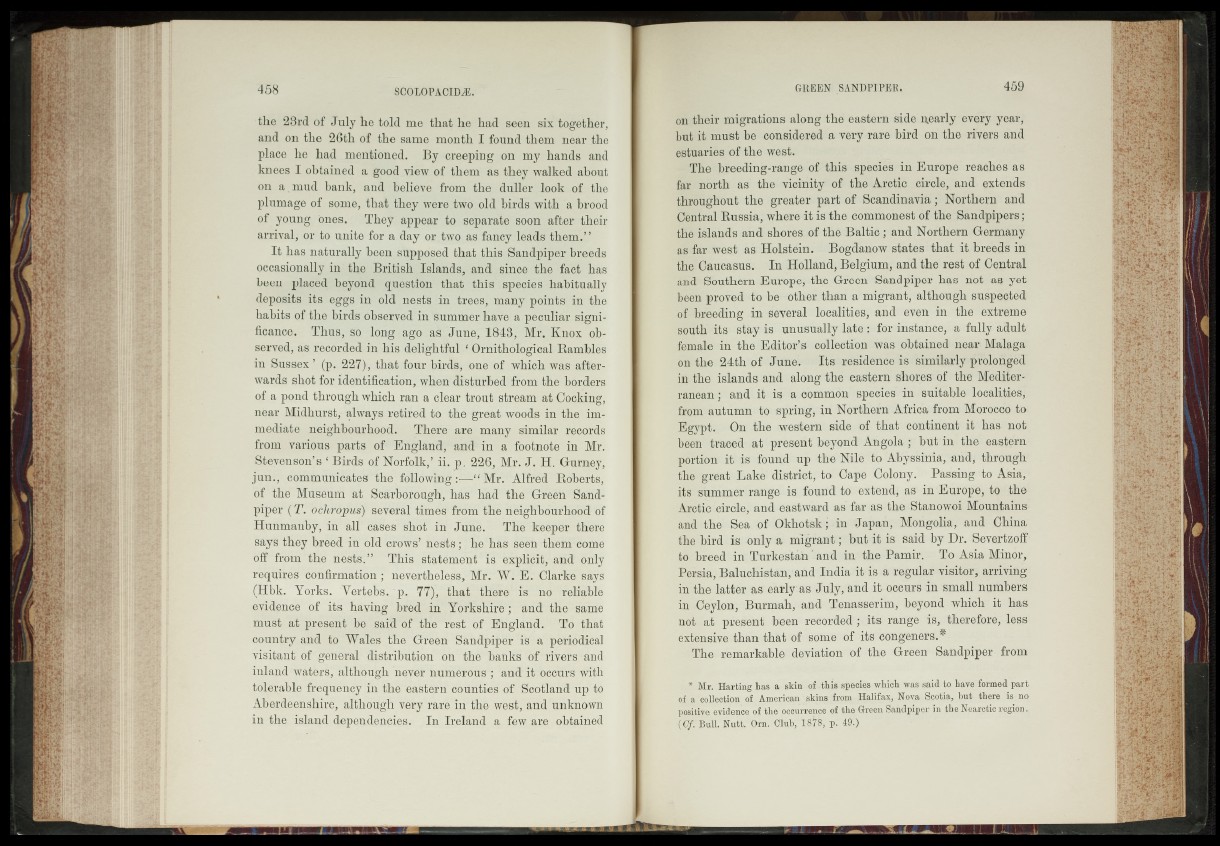
the 28rd of July he told me that he had sees six together,
and on the 26th of the same month I found them near the
place he had mentioned. ■ By creeping on my hands and
knees I obtained a good view of them. as they walked about
on a . mud bank, and believe from the duller -look of the
plumage of some, that they were two old birdi with a brood
of young ones. ? They appear to separate soon afterH^eir
arrival, or to unite for a day or,two.as fancy leads them.”
It has naturally been supposed that this Sandpiper breeds
occasionally in the, British Islands, and since -the fact' has
been placed beyond question that this species ^habitually
deposits its;eggs in old nests in trees, many points;!® the
habits of the birds'observed in Bummer have a peculiar significance,
Thus, so long ago as Junef5|§4’8, Mr.-Knox observed,
as recorded in his delightful | Ornithological Rambles
in Sussex’ (p. 227)iihaiofour birds,Jone of which was afterwards
shot for ldentifi’catien^ when disturbed;-from the>.borders
of a pond through which ran a clear trout stream at Cocking,
near Midhurst,- always retired to the great woodadn the- immediate
-neighbourhood. There- are many similar records
from various parts of England, and flip a ;febtnote( in Mr.
Stevenson’s ’‘/Birds of N o r f o l k , 226, Mr. J. H. Gurney,
jun;, communicates v‘t'he‘ foHo wmi p f ^ Mf:; Alfred-BMMts,
of the Mu^ddih 'a't S&^rpWdugH, "has" had1 t^^S^^fe^an d -
piper'(T:Wch'fQ^Jsf sevStal tfk x itfrom' the^iMghbour'hobdrpf
Hunmanby, in* all bases* s'K.otv inf June.5’ The keeper^ftfeie
says they breed in old crows’ nSsfs^" ’lie ’'Mil S'ebn^thehrtome
off 'from ilpe -if'elfBf3 - ' This st^temdnt ^is/ ’ expliditf ahd^illlfy
re'quireS^»rifirmalio^T nevertheless, Mr. WjyjEd; ClarkefiSp
(Hbk. Yorks, 'yeitejbs ^ p., thdt" tlfede?
evidence pf its, laying 1 bred' in Yorkshire*; and the same
must at p r e s e n t o f ^ E b ^ a h d . To that
country and to Wales the Greem’Sahdpipfe^i¥j-aiipe¥i16dica]
yiSitaui qffjpmeral ^stfibtftipn^'on thdlbahl?S'“r6Mdvh¥s5and
hdand •'wat%|’!, although Vevelwhq^5ro|,'s"'; 3aifdii^ c t^ ra ' with
tolerable'■fr'e^l^i^ in tbe^easiierh cbuhtieb of '^cqtlahdsup IS
Aberdeenshirc,1afth^^hJveiy rarein the west,"and unkh’owh
in the, island dependerj^ij^ In Ireland -„a^fe»^^ obtained
on their migrations along the eastern side.: nearly every year/
but5it must be considered a very rare bird oh the rivers and'
estuaries of the west
The breeding-range of this species in Europe reaches as
far north as the vicinity’ of the Arctic circle, and extendi;
throughout the greater part of Scandinavia;' Northern and
Cediral Russia, where it is the commonest of the .Sandpipers;
the islands and'shores of the Baltic; and Northern Germany
as far:west as Holstein. Bogdanow states that.it breeds if |
the Caucasus^ "In Holland, Belgium;, and the rest of Central
and Southern Europe, the Green Sandpiper has ho|r as yet,
been proved to heather;than a migrant, although suspected
of ^breeding -in Several localities, and even5 mt the extreme
south, its’.'slay is unusuRlly..'lat^^r a fuliy adulfe
female in the Editor’s collection..wassobtained near: Malaga
on the 24th‘pf Junel I ts : riSidbftce^s feimi’Mypfolohged
in'the islands and alongside eastern-shores", of the Mediier-
ranean; and it* is a.commom-Spebieslib: suitable localities,"
frpm autumn to- spring, 'in Northern Africa from Morocco to/
Egypt. On- She western: side -'of that continent it has not
been traced- at- present,;beye&-d& Angola'fr bukinlthel eastern
perti<fa& i#-is found up -the Nile to Abyssinia,"and; through'
the great Lake- distric't|?4bivCtp'e Colony/1 Passing do Asia,
its'"'summer, range is found to^nitend; as- in Europe, to-' the’
Arctic icheie:‘t-and eastward as far as, the Btaue^o'i Mountains-
and the; -Sea of Okhotsk-/ in Japah;v|\fbhgOlia, and China5
th||bWn -is only a migrant ; -’but it is said by Dr. Sev$rtzoff'
todhreed ihTurkestah * andKdn' the Pamir. - To Asia Ipnor,
Persia, BaludEstahyand Ind-indtT&i, regular visitor, arriving
in the latter ras" early'as ;#dly4#md it-occurs in small numbers
in lf^ to n , Burmah, and Tpnasserimy'beyohd -which- it has
not .at present. been recorded ;-yits: range.% therefore,-less
extensive than that5# some/if its^n^en'eri*-
. fec.be' lfimarkable-. dev-iation-'-of-; the Greens Sandpiper from
a#..Mr. Halting has a skin Q#*this-speeies ifriuch. was sa id ^ h a v e formed |>art
of-,a;[coljcctio^ of* American ^kins fromr Halifax, N t h e r e ’i s - ^
positi\( ^evidence of’the peciuTeupe of thoGieen s^ndpipm in the^cargtic pgion*
(■l^Ball. Nutt.^OrA^Cliih, p 19-) ’’’